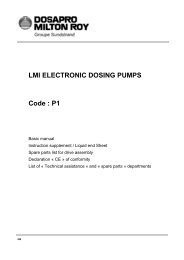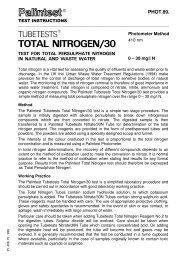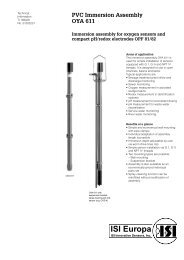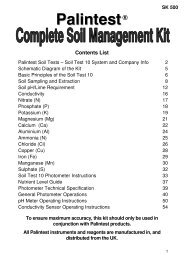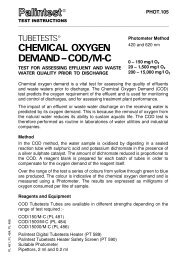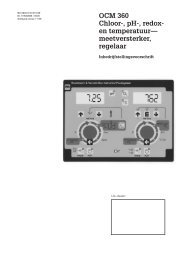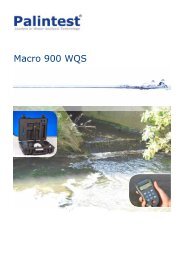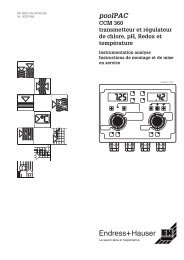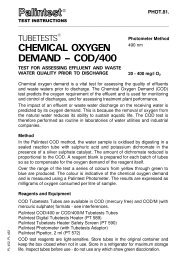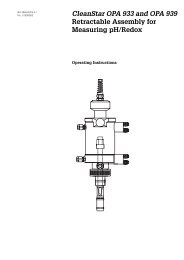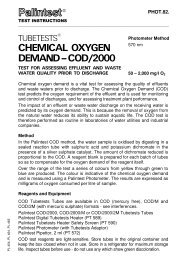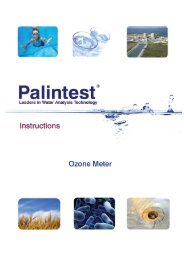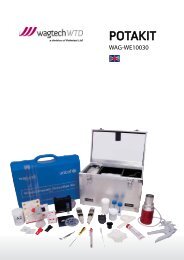COD - 1000 Tubetests (PDF) - Palintest
COD - 1000 Tubetests (PDF) - Palintest
COD - 1000 Tubetests (PDF) - Palintest
You also want an ePaper? Increase the reach of your titles
YUMPU automatically turns print PDFs into web optimized ePapers that Google loves.
<strong>Palintest</strong><br />
®<br />
PHOT.84.AUTO<br />
TEST INSTRUCTIONS<br />
_______________________________________________________________________________________<br />
Photometer Method<br />
AUTOMATIC<br />
WAVELENGTH<br />
SELECTION<br />
10 – 1,000 mg/l O 2<br />
Chemical oxygen demand is a vital test for assessing the quality of effluents<br />
and waste waters prior to discharge. The Chemical Oxygen Demand (<strong>COD</strong>)<br />
test predicts the oxygen requirement of the effluent and is used for monitoring<br />
and control of discharges, and for assessing treatment plant performance.<br />
The impact of an effluent or waste water discharge on the receiving water is<br />
predicted by its oxygen demand. This is because the removal of oxygen from<br />
the natural water reduces its ability to sustain aquatic life. The <strong>COD</strong> test is<br />
therefore performed as routine in laboratories of water utilities and industrial<br />
companies.<br />
Method<br />
The <strong>Palintest</strong> <strong>COD</strong> method conforms to the following standard methods for<br />
determining <strong>COD</strong>:<br />
This method conforms to the sealed tube reflux version of methods detailed<br />
in the following reference texts.<br />
1 Standard Methods for the Examination of Water and Wastewater. 21 st<br />
Edition. 2005. American Public Health Association, American Water<br />
Works Association and Water Environment Federation.<br />
Section 5220 D. Pages 5-14 to 5-19.<br />
2 Methods for the Examination of Waters and Associated Materials 2006.<br />
Standing Committee of Analysts.<br />
The determination of chemical oxygen demand in waters and effluents (<br />
2006).<br />
3 British Standard BS ISO 15705:2002 BS 6068-2.80:2002<br />
Water Quality- Determination of the chemical oxygen demand index (ST-<br />
<strong>COD</strong>)—Small –scale sealed-tube method.
PL 454, PL 464, PL 465 AUTO<br />
Over the range of the test a series of colours from yellow through green to<br />
blue are produced. The results are expressed as milligrams of oxygen<br />
consumed per litre of sample.<br />
Reagents and Equipment<br />
<strong>COD</strong> <strong>Tubetests</strong> Tubes are available in different formats - see interferences.<br />
<strong>Palintest</strong> <strong>COD</strong>/<strong>1000</strong>, <strong>COD</strong>/<strong>1000</strong>/M or <strong>COD</strong>/<strong>1000</strong>/2M <strong>Tubetests</strong> Tubes<br />
<strong>Palintest</strong> Digital <strong>Tubetests</strong> Heater (PT 589)<br />
<strong>Palintest</strong> <strong>Tubetests</strong> Heater Safety Screen (PT 590)<br />
<strong>Palintest</strong> Automatic Wavelength Selection Photometer<br />
<strong>Palintest</strong> Pipettor, 2 ml (PT 572)<br />
<strong>COD</strong> test reagents are light-sensitive. Store tubes in the original container and<br />
keep the box closed when not in use. Store in cool, dry conditions.<br />
Working Practice<br />
The <strong>Palintest</strong> <strong>COD</strong> test is a simplified laboratory procedure and should be<br />
carried out in accordance with good laboratory working practice. The reagent<br />
tubes contain 84% sulphuric acid and must be handled with care. The<br />
Material Safety Data Sheet (MSDS) is the document that contains information<br />
on the potential hazards (health, fire, reactivity and environmental) and how to<br />
work safely with the chemical product. It is an essential starting point for the<br />
development of a complete health and safety program. It also contains<br />
information on the use, storage, handling and emergency procedures all<br />
related to the hazards of the material<br />
Reagent tubes should not be opened whilst hot as pressure build-up may<br />
cause acid spillage. Do not open tubes during or after sample digestion.<br />
Sample Preparation<br />
Effluents and waste water samples may contain undissolved or particulate<br />
material. Such samples may be homogenised in a blender prior to the test in<br />
order to improve accuracy and reproducibility
Reagent Blank<br />
In this test a reagent blank is used instead of the usual water blank referred to<br />
in the general photometer operating instructions. The reagent blank is<br />
prepared by adding deionised or distilled water to the reagent tube (see Test<br />
Procedure, Step 4) and then digesting the tube in the same manner as for the<br />
water sample.<br />
It is not necessary to prepare a reagent blank each time the test is carried out.<br />
The reagent blank tube may be prepared weekly and used repeatedly with all<br />
samples prepared from the same batch of reagent tubes. The reagent blank<br />
should be stored in the dark between uses.<br />
Test Procedure<br />
1 Turn on <strong>Tubetests</strong> heater, set the control to 150°C and place the safety<br />
shield in position. Allow the heater to heat up to temperature (see<br />
<strong>Tubetests</strong> Heater).<br />
2 Prepare the SAMPLE TUBE as follows. Shake tube vigorously to suspend<br />
all sediment. Remove the cap of the <strong>COD</strong> <strong>Tubetests</strong> tube and add 2 ml of<br />
sample using a <strong>Palintest</strong> pipettor.<br />
3 Replace the cap tightly and invert tube gently to mix contents. The tube<br />
will become hot on mixing. Ensure all of the precipitate is suspended<br />
before proceeding. Label the tube using the labels provided in the reagent<br />
pack and place the tube in the <strong>Tubetests</strong> heater. Ensure the safety screen<br />
is in position.<br />
4 Prepare a REAGENT BLANK by repeating steps 2 and 3 using 2 ml of<br />
deionised or distilled water in place of the sample. This stage may be<br />
omitted if a suitable reagent blank tube is already available (see Reagent<br />
Blank).<br />
5 Digest the tubes for two hours then turn off the heater unless it is required<br />
for further tests.<br />
6 Carefully remove each tube, invert gently to mix and then transfer to a test<br />
tube rack.<br />
7 Allow the tubes to cool to room temperature.<br />
8 Select Phot 84 on Photometer.<br />
9 Take the photometer reading (see photometer instructions).<br />
10 The result is displayed as mg/l O 2 .
Interferences<br />
Chloride is the main potential interference in the <strong>COD</strong> test. High chloride<br />
levels may result in an apparent high <strong>COD</strong> result. The <strong>Palintest</strong> <strong>COD</strong>/<strong>1000</strong><br />
test will not be significantly affected by chloride levels up to 100 mg/l. Samples<br />
containing above this level should be diluted so as to reduce the concentration<br />
to 100 mg/l or below and the test carried out on the diluted sample.<br />
If sample dilution is not possible then it may be necessary to suppress chloride<br />
interference. The method most commonly prescribed in standard analytical<br />
methods is the addition of mercuric sulphate to the reagent system.<br />
In the <strong>Palintest</strong> <strong>COD</strong>/<strong>1000</strong>/M test 0.04g of mercuric sulphate is provided in<br />
each tube of reagent and will suppress interference up to 2,000 mg/l chloride<br />
in sample containing 50 to 2,000mg/l <strong>COD</strong>. In the <strong>Palintest</strong> <strong>COD</strong>/<strong>1000</strong>/2M test<br />
0.08g of mercuric sulphate is provided and will suppress interference up to<br />
4,000 mg/l chloride in samples containing from 50 to 2,000 mg/l <strong>COD</strong>.<br />
Disposal<br />
The used <strong>COD</strong> <strong>Tubetests</strong> tubes contain strong sulphuric acid and other<br />
chemical reagents and care must therefore be exercised in their disposal. The<br />
tube contents should be disposed of in accordance with Local Authority<br />
requirements. A <strong>COD</strong> tube disposal service is available through <strong>Palintest</strong> Ltd<br />
(UK only). The tubes must not be re-used as they are designed for single use<br />
only.<br />
<strong>Tubetests</strong> Heaters<br />
The <strong>Palintest</strong> <strong>Tubetests</strong> heaters are dedicated heaters for use with the <strong>COD</strong><br />
<strong>Tubetests</strong> system. They comprise an electronically controlled dry bath which<br />
heats aluminium test tube blocks. The heaters are designed to provide the<br />
correct digesting and refluxing conditions necessary for the <strong>COD</strong> test. They<br />
provide the correct digestion temperature of 150°C ± 3°C in the reagent tubes.<br />
The <strong>Palintest</strong> Digital <strong>Tubetests</strong> Heater (PT 589) is a 12 tube heater featuring a<br />
digital display.<br />
To use the digital heater for the <strong>COD</strong> test, set the temperature on the digital<br />
display to 150°C.<br />
On no account must heaters be set at a higher temperature than that specified<br />
as this may cause a hazard through pressure build-up in the <strong>COD</strong> tubes.<br />
___________________________<br />
V3 – 11/11



